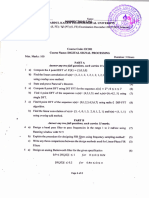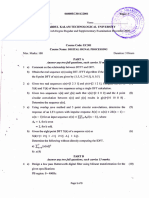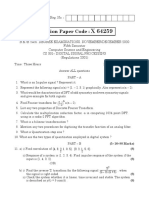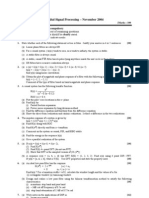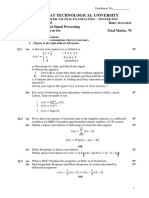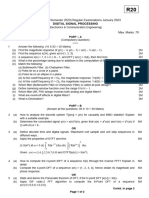Ec301 Digital Signal Processing June 2024
Ec301 Digital Signal Processing June 2024
Uploaded by
sandraCopyright:
Available Formats
Ec301 Digital Signal Processing June 2024
Ec301 Digital Signal Processing June 2024
Uploaded by
sandraOriginal Title
Copyright
Available Formats
Share this document
Did you find this document useful?
Is this content inappropriate?
Copyright:
Available Formats
Ec301 Digital Signal Processing June 2024
Ec301 Digital Signal Processing June 2024
Uploaded by
sandraCopyright:
Available Formats
A 16000Ec30tL2230t
Reg No.:
APJ ABDUL KALAM TECHNOLOGICAL UNIVE
B.Tech Degree 55 (S, FE) / S5.(PT) (S,FE) ExaminationJwre2024
Course Code: EC301
Course Name: DIGITAL SIGNAL PROCESSING
Max. Marks: 100 Duration: 3 Hours
PART A
Answer any twofull questions, each carries 15 marhs. Marks
1 a) .Consider x(n):{1,2,-3,0,1,-1,4,2) with an 8 point DFT X(k). Evaluate the (9)
following without finding DFT.
a) x(0) b)t|k=ox(k) c) 2'o=oe-# x1tcl d) X|=o lx(k)l'
(6)
b) Using equations, findthe 4 pointIDFT of X(k): {2,|+j,0, l-j }.
2 a) Find the output y(n) of a filter whose impulse response is h(n):{l,l,l} and input (10)
signal is x(n):{3,-1,0,1,3,2,0,1,2,1} using overlap add method.
b) Perform circular convolution of the given sequences using concentric circle (5)
x{n) - {1,-1,-2,3,-1} & xz(n) = {1,2,3}.
method:
3 a) FindDFTofasequencex(n):{0,1,2,3,4,5,6,7} usingDIT-FFTalgorithm. (ll)
b) Also compute the number of complex additions & multiplications required for (4)
conventional DFT & DIT FFT.
' ,ART B
Answer any nuofull questions, each caties 15 marks.
4 a) Determine the low pass filter coeffrcients h(n) by frequency sampling method for (8)
N:7.
" ( s-iaa o<lrl <l *;
Ha(ei') - |
10 i=ll'ol <n
b) For the analog transfer function, H(s) = 2/(s'* 3s * 2) determine H(z) using (7)
Impulse Invariance Method. Assume T:1 sec.
5 a) Design an ideal LPF with a frequency response given as follows. Find the values (8)
of h(n) forN:ll.
-l =' s;
Ha(eid')=Lfor
-oforX 3lrl{ <r
Page 1 of 2
t
16000Ec30t1,2230t
b) Explain the characteristics of the following window functions: (4)
(i) Hamming Window . (ii) Hanning Window
(3)
c) and z2 =
rrruzl represents a linear phase FIR filter and has zeros at
"r: #* i +
2- Find the remaining zeros and determine H(z)'
6 a) For the given specifications, design an analog Butterworth filter'
(10)
0'4 t < Ct 3 n
0.9S lH(iQ)l < 1, for 0 < dt 3 0'2r & lH(iQ)l < 0'2'for
(5)
b) Explain pre-warping in bilinear transformation'
PART C
Answeranytwofullquestions,eachcarrics20marks.
Explain transposed form of a filter structure. obtain the
transposed direct form II (10)
7 a)
for the given IIR filter'
7*22-t*z-2
n\Z)=-
I-iz-L+i"-'
b) obtain the followi ngrealiz"ations for the given FIR filter' (10)
(i) Direct form realization with minimum number of multipliers
(ii)Cascaderealizationwithminimumnumberofmultipliers
H(z) - ,-' +t1z-'z)(t +!"-' + z-2)
$*
8 a) obtain the cascade realization for the following system: (6)
' =iy(n-r)'iv(n-z)+ x(n)+Jx(n-r)
v(n)
(14)
. b) Realize the system with difference equation y(n) = -0.1y(n-
1)+0.72y(n-2)+0.7x(n)-0.252x(n-2)usingdirectforml,direct
II and
Parallel form'
, "* I
g a) With an example, illustrate the error inffiduced by truncation and rounding in (6)
floating point representation of numbers'
Explain the operations (7)
b) How is a floating-point number represented in a processor?
with examples'
of addition *a *umptcation of two floating point numbers
Explain ADC quantization noise. Derive the variance of
quantization noise in ADC (7)
c)
with steP size A.
,1. !F:f *'
Page2 of 2
You might also like
- Ec301 Digital Signal Processing, December 2023No ratings yetEc301 Digital Signal Processing, December 20232 pages
- Ec301 Digital Signal Processing, January 2023No ratings yetEc301 Digital Signal Processing, January 20232 pages
- Ec301 Digital Signal Processing, January 2022No ratings yetEc301 Digital Signal Processing, January 20222 pages
- C F1048 Pages:2: Answer Any Two Full Questions, Each Carries 15 MarksNo ratings yetC F1048 Pages:2: Answer Any Two Full Questions, Each Carries 15 Marks2 pages
- Ect303 Digital Signal Processing, December 2022No ratings yetEct303 Digital Signal Processing, December 20223 pages
- Ec301 Digital Signal Processing, December 2020No ratings yetEc301 Digital Signal Processing, December 20203 pages
- Answer Any Two Full Questions, Each Carries 15 Marks: Reg No.: - NameNo ratings yetAnswer Any Two Full Questions, Each Carries 15 Marks: Reg No.: - Name2 pages
- Ect303 Digital Signal Processing, December 2023No ratings yetEct303 Digital Signal Processing, December 20233 pages
- Ect303 Digital Signal Processing, December 2023No ratings yetEct303 Digital Signal Processing, December 20233 pages
- Shahjalal University of Science & TechnologyNo ratings yetShahjalal University of Science & Technology16 pages
- MA202 Probability Distributions, Transforms and Numerical Methods, April 2018 PDFNo ratings yetMA202 Probability Distributions, Transforms and Numerical Methods, April 2018 PDF2 pages
- EC6502 Principles of Digital Signal Processing 1234- By EasyEngineering.netNo ratings yetEC6502 Principles of Digital Signal Processing 1234- By EasyEngineering.net14 pages
- Btech Cse It Signals Systems 20161460440120No ratings yetBtech Cse It Signals Systems 201614604401203 pages
- F (T) F (3-2t) F (T) .: Answer Any Two Questions, Each Carries 15 MarksNo ratings yetF (T) F (3-2t) F (T) .: Answer Any Two Questions, Each Carries 15 Marks3 pages
- SCS6105200904 Digital Signals ProcessingNo ratings yetSCS6105200904 Digital Signals Processing5 pages
- AM-2008-4558Engineering-DSP - Anna UniversityNo ratings yetAM-2008-4558Engineering-DSP - Anna University3 pages
- Bapatla Engineering College::Bapatla: k δ (n−k) - π n) sin 0% (1)Bapatla Engineering College::Bapatla: k δ (n−k) - π n) sin 4 pages
- National Institute of Technology RourkelaNo ratings yetNational Institute of Technology Rourkela2 pages
- Electrochemical Processes in Biological SystemsFrom EverandElectrochemical Processes in Biological SystemsAndrzej LewenstamNo ratings yet
- Student Solutions Manual to Accompany Economic Dynamics in Discrete Time, secondeditionFrom EverandStudent Solutions Manual to Accompany Economic Dynamics in Discrete Time, secondedition4.5/5 (2)
- Organic Light-Emitting Transistors: Towards the Next Generation Display TechnologyFrom EverandOrganic Light-Emitting Transistors: Towards the Next Generation Display TechnologyNo ratings yet
- 2022 Practice PYQ Paper - Signals And Systems PYQNo ratings yet2022 Practice PYQ Paper - Signals And Systems PYQ8 pages
- Numerical Methods for Engineers and Scientists Using MATLAB Second Edition Esfandiari 2024 Scribd Download100% (1)Numerical Methods for Engineers and Scientists Using MATLAB Second Edition Esfandiari 2024 Scribd Download55 pages
- COMP4702 Notes 2019: Week 2 - Supervised LearningNo ratings yetCOMP4702 Notes 2019: Week 2 - Supervised Learning23 pages
- Lect. No. Topics To Be Covered Learning Objectives: Chapter in The Text BookNo ratings yetLect. No. Topics To Be Covered Learning Objectives: Chapter in The Text Book3 pages
- An Introduction To Coding Theory: Adrish BanerjeeNo ratings yetAn Introduction To Coding Theory: Adrish Banerjee28 pages
- Artificial Intelligence & Neural Networks Unit-5 Basics of NN50% (2)Artificial Intelligence & Neural Networks Unit-5 Basics of NN16 pages
- Digital Image Processing: Lecture12: Basics of Spatial FilteringNo ratings yetDigital Image Processing: Lecture12: Basics of Spatial Filtering16 pages
- Analysis of Algorithms CS 477/677: Instructor: Monica NicolescuNo ratings yetAnalysis of Algorithms CS 477/677: Instructor: Monica Nicolescu39 pages
